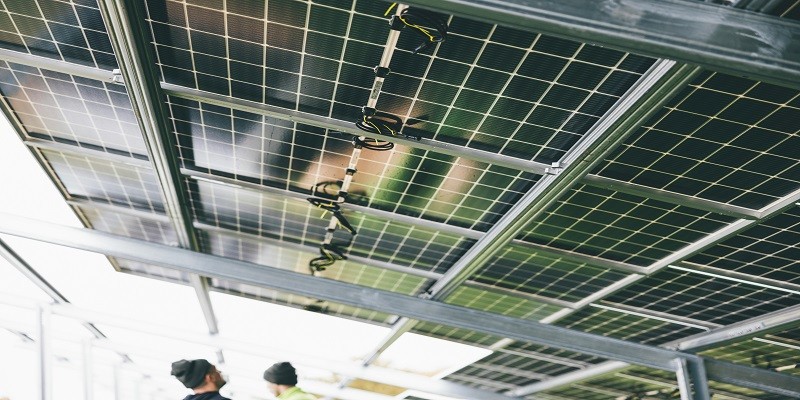Renewable Energy Tech: How Solar Panels are Becoming More Efficient
Solar panels are becoming more efficient due to advancements in renewable energy technology. In recent years, increased research and development efforts have led to significant improvements in the efficiency of solar panels, allowing them to convert more sunlight into usable electricity.
These advancements include innovations in photovoltaic cell materials, design techniques, and manufacturing processes. As a result, solar panels are now able to generate more electricity from the same amount of sunlight, making solar energy a more viable and sustainable option for meeting increasing energy demands.
With these ongoing improvements, the future of solar power looks promising, as it becomes an increasingly efficient and cost-effective source of renewable energy.
The Evolution Of Solar Panel Technology

Solar panel technology has come a long way since its inception, with significant advancements leading to increased efficiency and cost-effectiveness. The evolution of solar panel technology has fueled the widespread adoption of renewable energy sources, driving the transition towards a more sustainable future.
Read More – Cybersecurity in the Age of IoT: Protecting Your Digital Footprint
Early Solar Panel Technology
The early stages of solar panel technology were characterized by the use of bulky and inefficient photovoltaic cells, predominantly made of crystalline silicon. These early solar panels were limited in their capacity to harness solar energy, often providing low power output and requiring substantial space for installation.
Advancements In Solar Panel Efficiency
Recent years have witnessed remarkable strides in enhancing the efficiency of solar panels. Innovations such as thin-film solar cells, multi-junction photovoltaic cells, and improved panel designs have significantly boosted the energy conversion rates of solar panels, increasing their overall effectiveness in harnessing sunlight. These advancements have also led to a reduction in production costs, making solar energy an increasingly viable and competitive option for power generation.
Factors Driving Solar Panel Efficiency
When it comes to renewable energy technology, solar panels have become increasingly efficient over the years. This efficiency can be attributed to several factors, including materials and manufacturing innovations as well as improved energy conversion processes. Let’s take a closer look at each of these factors.
Read More – Simple Tips to Improve Your Website’s SEO with Smart Linking
Materials And Manufacturing Innovations
The materials used in solar panels play a crucial role in their efficiency. Innovations in materials have allowed for the development of panels that can convert sunlight into electricity with higher efficiency. Some of these materials include:
- Monocrystalline Silicon: This material has a higher purity level and better light absorption, making it more efficient at converting sunlight into electricity.
- Polycrystalline Silicon: Although slightly less efficient than monocrystalline silicon, this material is more cost-effective and widely used.
- Thin-Film Technologies: Thin-film solar panels, like those made from amorphous silicon or cadmium telluride, are flexible and lightweight. While they may have lower efficiency rates compared to crystalline silicon panels, they can be more suitable for certain applications due to their flexibility.
Alongside material innovations, advancements in manufacturing techniques have also contributed to improving solar panel efficiency. Manufacturers have been able to reduce production costs and enhance the overall quality of panels through:
- Wireless Interconnects: This reduces power losses and enhances panel performance.
- Anti-Reflection Coatings: These coatings minimize light reflection, allowing more sunlight to reach the solar cells and increasing overall efficiency.
- Nanostructured Surfaces: By incorporating nanostructures on the panel’s surface, manufacturers can enhance light absorption and reduce reflection.
Improved Energy Conversion Processes
Efficiency gains in solar panels can also be attributed to advancements in energy conversion processes. Over the years, researchers and engineers have focused on increasing the amount of sunlight that can be converted into electricity. This has led to the development of:
- Multijunction Cells: These cells combine different materials to capture a broader range of sunlight wavelengths and convert them into usable electricity.
- Passivated Emitter Rear Contact (PERC) Technology: PERC technology reduces energy losses by adding a layer at the back of the solar cell, improving its ability to capture and convert sunlight into electricity.
- Bifacial Panels: Bifacial panels can capture sunlight from both sides, increasing the overall solar energy conversion and maximizing efficiency by utilizing reflected and diffused light.
With ongoing research and development in these areas, solar panels are poised to become even more efficient in the future. These factors driving efficiency improvement not only contribute to a more sustainable and eco-friendly energy solution but also make solar power more accessible and cost-effective for both residential and commercial applications.
Read More – The New Frontier: Exploring the Potential of Space Tourism
Challenges And Limitations In Increasing Efficiency
While solar panels continue to advance in efficiency, there are still several challenges and limitations that need to be addressed. Some of the key factors impeding the improvement of solar panel efficiency include:
Cost Considerations
One of the major challenges in increasing the efficiency of solar panels is the cost associated with the advanced technologies and materials required to enhance performance. High-quality materials drive up the overall manufacturing cost of solar panels, making them less affordable for many consumers and businesses. Additionally, the research and development expenses to create innovative technologies that boost efficiency are substantial.
Intermittency And Storage Issues
The intermittent nature of solar energy production poses another challenge in increasing efficiency. Solar power generation relies on sunlight, which is not available 24/7. This intermittency can lead to fluctuations in energy production, making it difficult to rely solely on solar energy. Additionally, efficient storage solutions are needed to store excess energy produced during peak sunlight hours for use during low sunlight periods, reducing reliance on fossil fuel-based backup systems.
Future Trends In Solar Panel Efficiency
Solar energy is rapidly advancing, and the future of solar panel efficiency holds exciting prospects. With emerging technologies and integration with energy grids, solar panels are becoming ever more efficient, making renewable energy a more viable and sustainable option.
Emerging Technologies
New technologies are continuously being developed to enhance the efficiency of solar panels. From advanced photovoltaic materials to innovative manufacturing processes, researchers and engineers are working tirelessly to increase the conversion efficiency of solar cells. Nanotechnology and perovskite solar cells are among the promising advancements that show the potential to boost solar panel efficiency.
Integration With Energy Grids
Solar panels are not only becoming more efficient in capturing sunlight but also in integrating with energy grids. The integration of solar energy systems with smart grids allows for better management and distribution of electricity. Smart inverters and energy storage solutions are being developed to efficiently integrate solar power into the existing energy infrastructure, further optimizing the overall effectiveness of solar panel technology.
Frequently Asked Questions
What Factors Contribute To Solar Panel Efficiency Improvements?
Solar panel efficiency is influenced by technological advancements, material quality, and design modifications.
How Do Solar Cells Convert Sunlight Into Electricity?
Solar cells utilize a photovoltaic effect to convert sunlight into electricity, generating clean renewable energy.
Are There Any Emerging Technologies Boosting Solar Panel Efficiency?
Innovations like bifacial solar panels, perovskite cells, and smart tracking systems enhance efficiency.
How Are Solar Panels Adapted To Different Environmental Conditions?
Solar panels can be optimized with tilt adjustments, cleaning maintenance, and weather-resistant materials.
What Impact Do Efficient Solar Panels Have On Renewable Energy Production?
Efficient solar panels increase energy output, lower costs, and contribute to sustainable power solutions.
Conclusion
Solar panel technology is advancing rapidly, leading to increased efficiency and affordability. This trend is driving the widespread adoption of solar energy as a viable alternative to traditional power sources. As advancements continue, the potential for solar energy to revolutionize the energy landscape is promising.
Embracing solar technology is crucial for a sustainable future.

